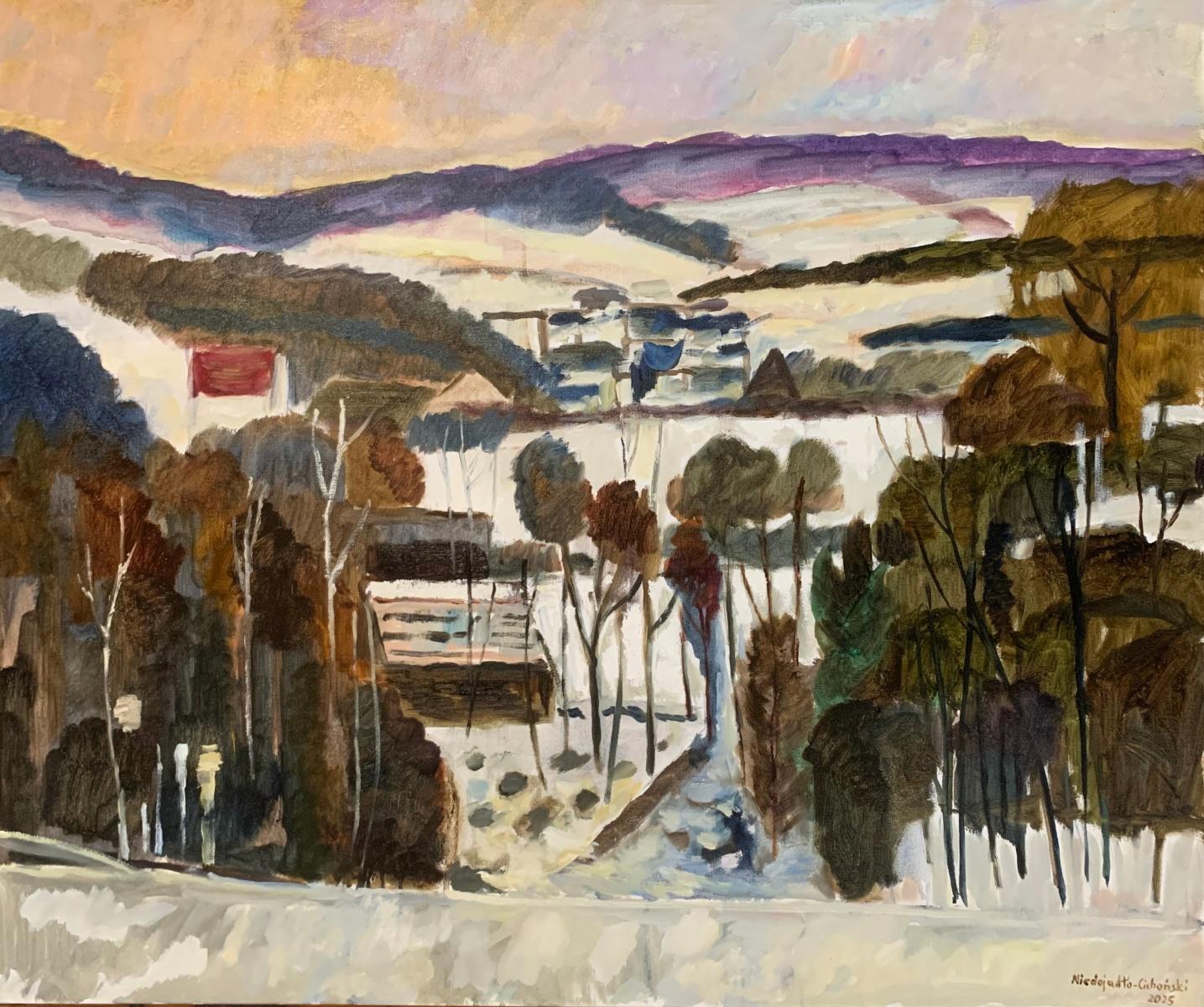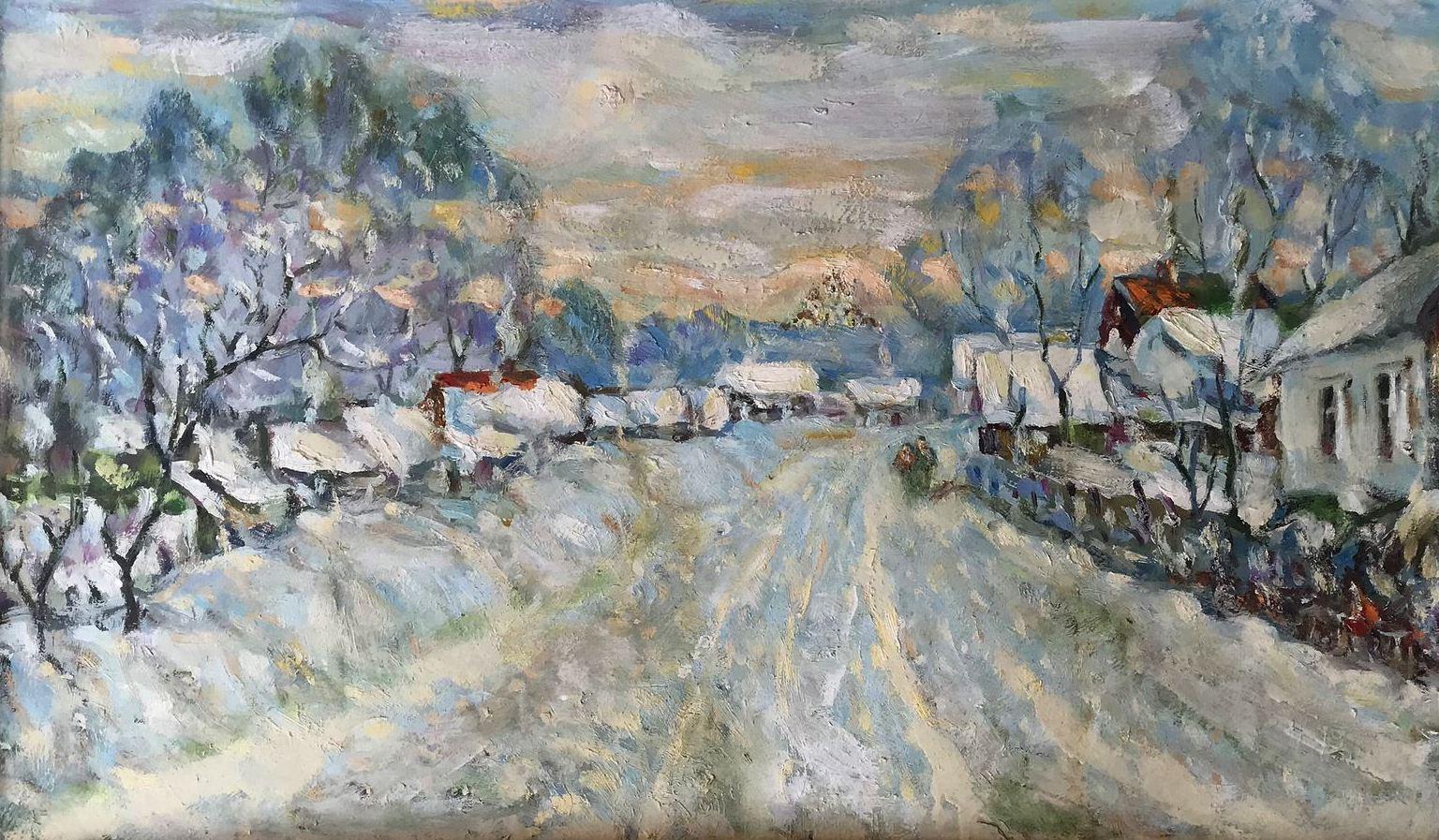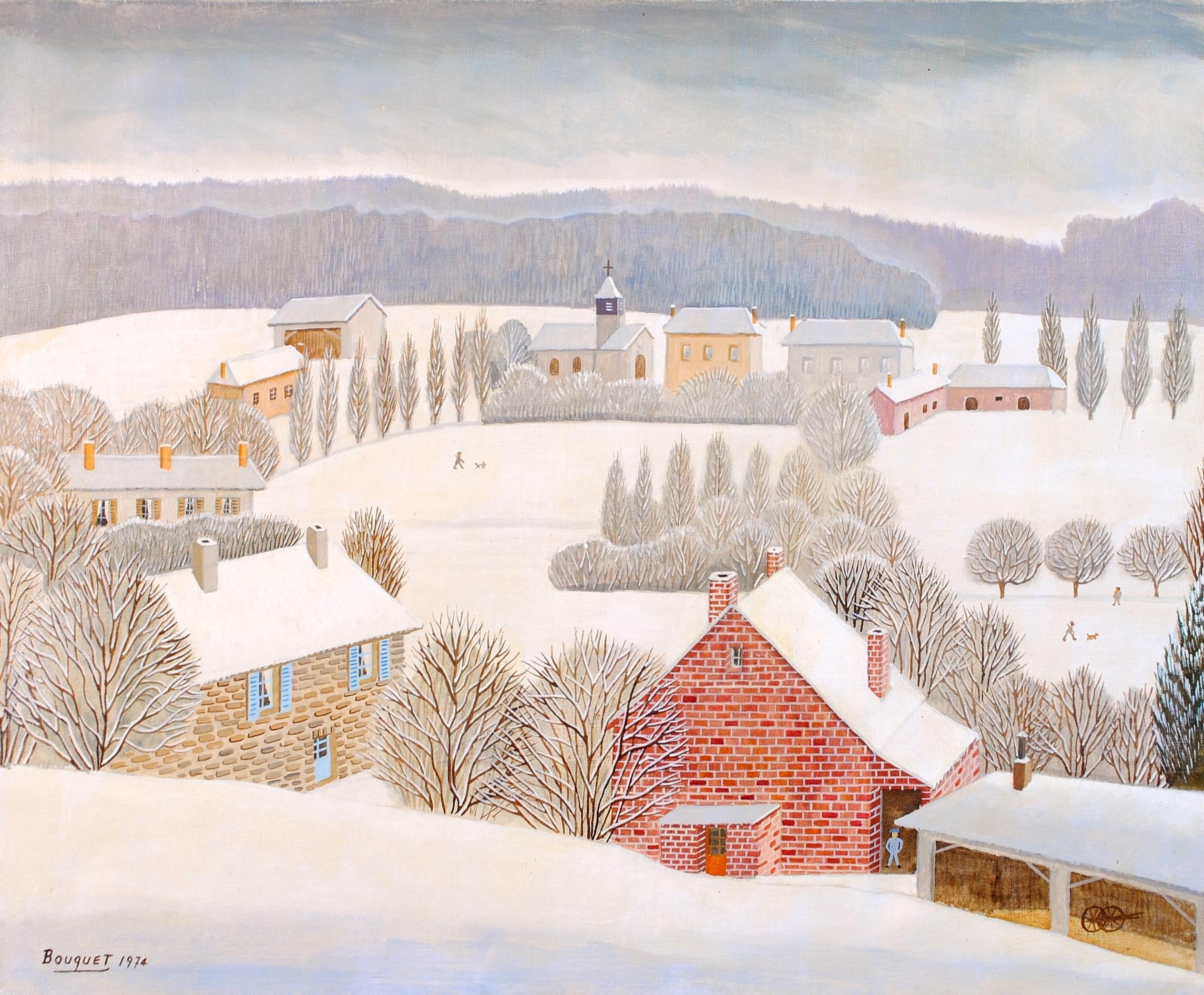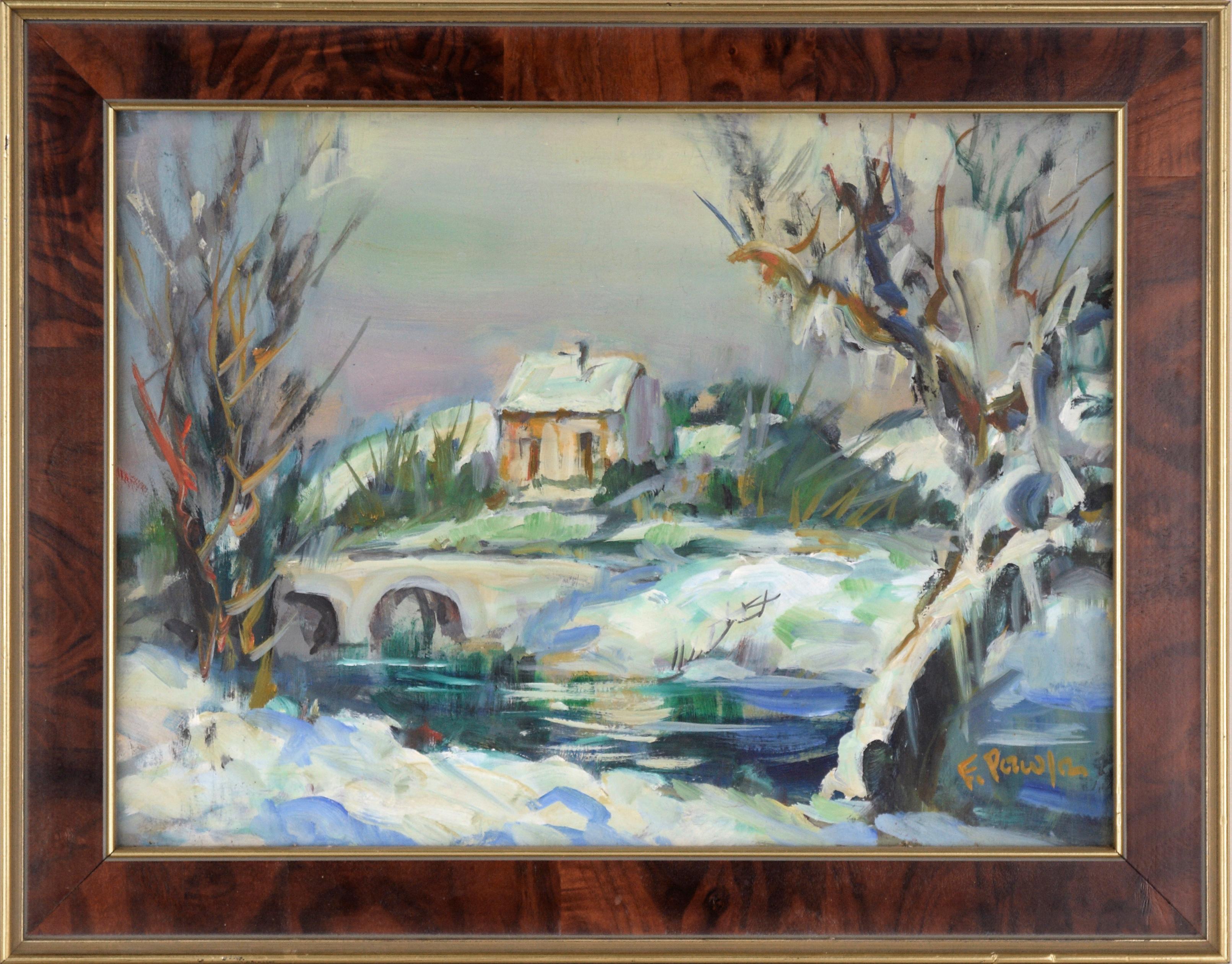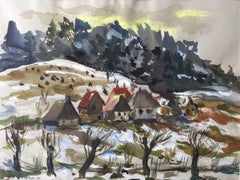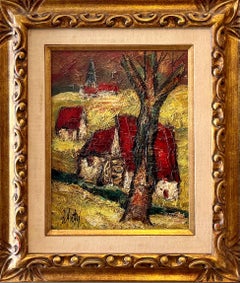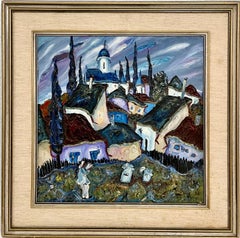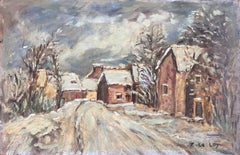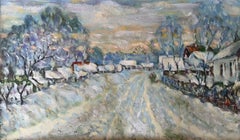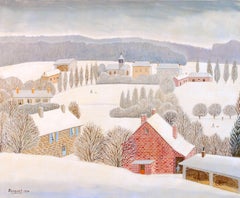Items Similar to Polish Modernist Village landscape in the Snow Oil Painting
Want more images or videos?
Request additional images or videos from the seller
1 of 7
Bronislaw LinkePolish Modernist Village landscape in the Snow Oil Painting
$2,200
£1,692.39
€1,964.38
CA$3,102.53
A$3,475.35
CHF 1,825.38
MX$42,259.14
NOK 23,115.26
SEK 21,942.60
DKK 14,660.92
About the Item
Bronisław Wojciech Linke, (born 23 April 1906 in Tartu, Estonia, died 6 October 1962 in Warsaw, Poland), was a painter and graphic artist noted for his metaphorical realism in his depiction of human destructiveness.
He was born into the Polish community in Estonia, the son of a notary, Juliusz Ferdynand Linke and Maria, née Starorypińska. In 1919 the family were 'repatriated' to Poland and settled in Kalisz, a town destroyed in 1914.
He began his art studies in the Bydgoszcz School of Industrial Art 1922–1923. He spent the next two years in the Kraków Art School, followed by five years at the Warsaw Academy of Art 'ASP', under the direction of Tadeusz Pruszkowski. He joined the 'Wolnomalarska Lodge' (a painterly pun in Polish on freemasonry) and was a member of the „Powiśle” group before and after the Second world war.
His début as a graphic artist was in the columns of the satirical review, Szpilki in 1936. He contributed illustrations to such publications as Dziennik Ludowy, Nowe Życie, Sygnały, Tygodnik Robotnika, and after the war to Polityka and Trybuna Ludu.
As an artist, he worked in thematic periods. His earliest such period of drawings took the title, War (1931–1932), followed by a series called Miasto, 'the City' (1931–1935).
He was a friend of Stanisław Witkiewicz with whom he made a trip to Silesia. The result was a series of 30 drawings under the heading of Śląsk. In May 1938 an exhibition of these latest works in the Instytut Propagandy Sztuki (Institute for the Propagation of Art) was shut down on account of its potentially 'pernicious social effects'.
After the outbreak of World War II, he was forced to flee with his wife and they went to Lwów, for fear of Nazi reprisals for his cartoons of Adolf Hitler that had appeared in the press. In 1942 he was exiled to Orsk in the Ural Federal District. Only in 1946 was he able to return to Poland from there.
On his return to Warsaw he painted his most celebrated Screaming Stones series (1946-56). It was a terrifying vision of the capital in ruins. The work was eponymously published in 1959 with an introduction by Maria Dąbrowska. After the war he exhibited rarely as his work did not cohere with the then prevailing political climate. He was widowed and remarried before the war. There were no children. Linke died of cancer and is buried in Powązki Military Cemetery in Warsaw.
Linke's creativity is often characterized as metaphorical realism. His art is based on visualisations, as it were depictions of literary metaphor. Both the composition of individual works and the structure of his series rest on an evident narrative approach. Most of his work is on paper with the use of Water colour, Gouache, Crayon, pencil or Indian ink. He often scraped the surface of the paper and applied Collage. One of his most famous and late works is the Bus, a palpable reference to Stanisław Wyspiański's play, Wesele, The Wedding. As in the drama, so the figures on the Bus can be seen as slaves who stand in the way of their own liberation. A song, Czerwony autobus was inspired by the painting. In 1981 the poet Jacek Kaczmarski was further inspired by the same painting to write a poem Kanapka z człowiekiem.Another noted Linke work is „Modlitwa zamordowanych”, Prayer of the Murdered from 1942.
In 1991 Grzegorz Dubowski directed a documentary film entitled, Bronisława Linkego opisywanie świata, 'The World as described by Bronisław Linke'.
- Creator:Bronislaw Linke (1906 - 1962, Polish)
- Dimensions:Height: 19.5 in (49.53 cm)Width: 23 in (58.42 cm)
- Medium:
- Movement & Style:
- Period:
- Condition:warping to board.
- Gallery Location:Surfside, FL
- Reference Number:1stDibs: LU38212571692
About the Seller
4.9
Platinum Seller
Premium sellers with a 4.7+ rating and 24-hour response times
Established in 1995
1stDibs seller since 2014
1,786 sales on 1stDibs
Typical response time: <1 hour
- ShippingRetrieving quote...Shipping from: Surfside, FL
- Return Policy
Authenticity Guarantee
In the unlikely event there’s an issue with an item’s authenticity, contact us within 1 year for a full refund. DetailsMoney-Back Guarantee
If your item is not as described, is damaged in transit, or does not arrive, contact us within 7 days for a full refund. Details24-Hour Cancellation
You have a 24-hour grace period in which to reconsider your purchase, with no questions asked.Vetted Professional Sellers
Our world-class sellers must adhere to strict standards for service and quality, maintaining the integrity of our listings.Price-Match Guarantee
If you find that a seller listed the same item for a lower price elsewhere, we’ll match it.Trusted Global Delivery
Our best-in-class carrier network provides specialized shipping options worldwide, including custom delivery.More From This Seller
View AllEuropean Winter Landscape
By Katherine Librowicz
Located in Surfside, FL
Katarzyna LIBROWICZ
Polish French painter studied at the Academy of Fine Arts in Warsaw and arrived in France in 1937 .
She studied with André Lhote in Montparnasse Paris and exhib...
Category
20th Century Post-Impressionist Landscape Drawings and Watercolors
Materials
Watercolor
French Modernist Oil Painting Expressionist Village Farm Landscape Ecole Paris
By Henri d'Anty
Located in Surfside, FL
Framed 21 X 18 canvas 13 X 10
Henri Maurice D'Anty, listed French artist,Henry d'Anty 1910-1998
Born 1910 in Belleville France. Died in December 4 1998.
Educated at the Académie de...
Category
20th Century Expressionist Landscape Paintings
Materials
Canvas, Oil
French Modernist Mid Century Abstract Village Landscape Oil Painting
By Henri d'Anty
Located in Surfside, FL
Signed lower right, "d'Anty", a fine and early impression in excellent condition.
A noted member of the second generation of the School of Paris, Henri d'Anty won the Prix Cezanne in 1959 and the Prix Populiste in 1973. He is listed in all relevant art reference works including Benezit which gives a signature sample. We are pleased to offer a vibrant graphic work by this French Post-Impressionist...
Category
20th Century Post-Impressionist Landscape Paintings
Materials
Oil
Russian Abstract Expressionist Village Oil Painting Soviet Non Conformist Art
By Myhaylo Shteinberg
Located in Surfside, FL
Russian Abstract Expressionist Village Oil Painting Soviet Non Conformist
Frame: 27.5 X 27.5
Image: 19.5 X 19.5
Artist: Myhaylo Shteinberg (aka Mykhaylo Shteinberg, Michael Steinberg)
The Russian artist Michael Steinberg was born in Kishinev (Russia) in 1933. He started painting in the latter part of the 1950s in the city of Lvov.
Shteinberg was a key figure of the nonconformist avant garde movement in the Soviet era and painted in the genres of surrealism and expressionism. In the 1970s he was quite active in the artistic life of Lvov and Moscow and in 1974 he participated in the famous "Bulldozer Exhibition". The “Bulldozer Exhibition” became was the apogee of unofficial art's history. In 1974, in the Moscow park Belyaevo, the authorities destroyed art by many unofficial artists, among them Oskar Rabin, Lidia Masterkova, Evgeny Rukhin...
Category
20th Century Impressionist Landscape Paintings
Materials
Canvas, Oil
WPA Period "Coastal Village" American Modernist Realism Oil Painting Lev Landau
By Samuel David Lev-Landau
Located in Surfside, FL
Signed and titled with Yiddish inscription verso.
9 X 12 inches board size. beng sold unframed.
Painter, New York, N.Y. Samuel David Lev-Landau was born in Warsaw, Poland and emigr...
Category
Mid-20th Century Modern Landscape Paintings
Materials
Oil
Social Realist Street Scene Modernist Landscape Oil Painting
By Paul Zimmerman
Located in Surfside, FL
Oil Painting Mid 20th century, signed P. Zimmerman Reminiscent of the Mid Century Social Realist and WPA works of Ben Shahn this captures an architectural street scape...
Category
Mid-20th Century American Modern Landscape Paintings
Materials
Oil
You May Also Like
French Impressionist Village Snow Scene with Cottages and Trees
Located in Cirencester, Gloucestershire
Title: French Impressionist Village Snow Scene with Cottages and Trees
By F Le Lay
Signed: Yes
Size: 10.5 x 16.25 inches (height x width)
Oil painting on board, unframed
Condition: T...
Category
20th Century Impressionist Landscape Paintings
Materials
Oil
Podgorze in winter. Oil Landscape Painting, Geometric, Figurative, Polish artist
By Marek Niedojadło
Located in Warsaw, PL
Colorful figurative oil on canvas landscape painting by Polish artist Marek Niedojadlo-Cichonski. Artwork is horizontal, it depicts a rual view in which shapes are simplified and clo...
Category
2010s Other Art Style Figurative Paintings
Materials
Canvas, Oil
A snowy day, Landscape, Original oil Painting, Handmade, Ready to Hang
Located in Granada Hills, CA
Artist: Shapoval Ivan Leontyevich
Work: Original oil painting, handmade artwork, one of a kind
Medium: Oil on Cardboard
Style: Impressionism
Year: 2013
Title: A Snowy Day
Size: 15.5...
Category
2010s Impressionist Landscape Paintings
Materials
Oil, Cardboard
Village in Winter - Mid 20th Century French Naif Snowy Landscape Oil Painting
By André Bouquet
Located in Sevenoaks, GB
A beautiful signed and dated 1974 French naif oil on canvas landscape by André Bouquet depicting a snow covered village in winter.
André Bouquet was a butcher by trade who featured ...
Category
Mid-20th Century Landscape Paintings
Materials
Oil
Country Home in the Snow - Landscape
By Frederick Pawla
Located in Soquel, CA
Idyllic depiction of a house by a stream in winter by Frederick A. Pawla (British, 1876-1964). Signed "F. Pawla" in the lower right corner. Presented in a wood frame with gilded edge...
Category
Early 20th Century Impressionist Landscape Paintings
Materials
Oil, Masonite
$760 Sale Price
20% Off
"Village in the snow" Snow, white, landscape, Christmas cm. 33 x 46 1974
By Boris LAVRENKO
Located in Torino, IT
snow, winter landscape, house in the woods,russian art
Boris Lavrenko (Rostov, 1920 – St. Petersburg, 2001)
Works by Boris Lavrenko can be found in various private collections in ...
Category
1970s Impressionist Landscape Paintings
Materials
Oil
$2,283 Sale Price
30% Off
More Ways To Browse
Wedding In Paintings
Oil Painting Snow In Cities
Hitler Painting
Oil Painting Artists A Z
Vintage Indian Wedding
William Holland
Early 20th Century Realism Paintings
President Portrait Oil
Society Of Six Painting
California Desert Landscape Paintings
Fauvist Style Paintings
Wisconsin Landscape
Oil Painting Cornwall
Farmer Oil Paintings
J J Hill
Large Dutch Oil Paintings
Oxford Oil Painting
Winter Scenes Impressionists

